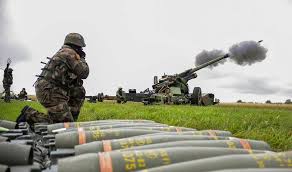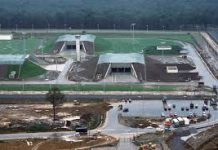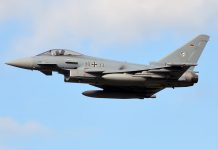
A French Army live-fire display in the country’s south-east last week — held amid heavy rain — highlighted a basic reality of modern combat: while artillery can still operate in foul weather, drones cannot.
The same lesson has emerged from Ukraine, where Russian forces have exploited rain and fog to time mechanized attacks, analysts at the Institute for the Study of War say.
Organizers at Camp de Canjuers had planned demonstrations of unmanned aerial systems and artillery together with manufacturer KNDS and several international delegations, after an unusually dry October at Europe’s largest permanently garrisoned training area. Instead, the storm grounded helicopters and drones, halted airdrops of gear and parachutists, and even disrupted nearby Nice airport traffic — creating holding patterns over Canjuers and making artillery firing less certain.
Still, the event illustrated how the 35th Parachute Artillery Regiment (35e RAP) is adapting to a battlefield where drones play a central role. The unit is deploying truck-mounted 20 mm guns, nets, decoys and handheld jammers to shield howitzer and mortar crews.
Despite intense focus on drones, lessons from Ukraine confirm that artillery remains crucial, said Lt. Col. Renaud Durbecq, the regiment’s operations and training chief. The 35e RAP fields the KNDS-made Caesar 155 mm howitzer as its primary gun. “Artillery is increasingly decisive on the battlefield because our guns can reach ranges where drones often cannot,” Durbecq told reporters at Canjuers.
Yet the regiment is rapidly “dronizing”: it now fields roughly five times as many drones as a year ago, has tripled its number of pilots, and logged twice the flight hours, according to Durbecq. The 35e RAP uses long-range Delair DT46 drones (about an 80 km range) for targeting and reconnaissance, smaller squad-level UAVs for local reconnaissance and defense, and FPV drones for scouting and strike tasks.
A significant tactical shift has been the speeding up of the intelligence-to-fire cycle: DT46s are being integrated directly into fire-control networks so batteries can engage targets immediately after drone detection. The regiment plans to double its DT46 capacity over the next year, Durbecq said, while declining to provide exact figures.
The unit has also taken delivery of six trial Proteus anti-drone systems to bolster counter-UAS capability. In tests carried out days before the demonstration, the 20 mm cannon shot down two drones that had been disabled by the Nerod handheld jammer from French firm MC2 Technologies, and it also destroyed a moving FPV drone. The 35e RAP is the first French formation to operate Proteus, which was assembled within four months by mounting a 1970s 20 mm anti-air gun on a 1980s four-wheel truck and pairing it with a thermal camera and fire-control computer.
The army is developing an upgraded Proteus featuring AI for better detection and plans to mount it on a modern Scania truck.
Ukraine’s evolving mix of drones and artillery has produced tactical innovations that may influence French practice, said Olivier Fort, a former artillery colonel now at KNDS who helps market the Caesar. One adaptation is pre-staging shells and propellant charges at firing points rather than carrying them on the truck — reducing the risk of catastrophic secondary explosions if struck by loitering munitions.
Fort warned that roughly three-quarters of artillery losses in Ukraine are caused by remotely controlled munitions such as Russia’s Lancet. Tracked, armored howitzers with internal automated loaders are particularly vulnerable because they carry their charges inside; by contrast, systems like the Caesar and Ukraine’s Bohdana are loaded externally. “The three kilograms in a Lancet won’t necessarily obliterate an artillery piece by itself,” Fort said, “but if ammunition is onboard, a secondary explosion can be devastating.” He cited attrition estimates for the 120 Caesars deployed to Ukraine at about 15%, while some tracked guns have suffered loss rates above 50%.
Another tactic observed in Ukraine is using artillery to destroy anti-drone nets and wiring that defend trenches and roads, clearing corridors for loitering munitions. Both sides increasingly emplace guns in dug-in positions, reducing the emphasis on immediate shoot-and-scoot mobility as counter-battery danger grows — though Fort argued mobility still matters for rapid resupply of shells and fuel. He noted that ammunition and fuel can be reloaded in minutes on the Caesar, whereas some tracked systems take much longer.
With Russian forces occasionally attacking a single vehicle with swarms of ten or twenty drones, Fort said anti-drone wiring alone may be insufficient. Effective protection combines camouflage, decoys, multiple counter-UAS systems and mobility — all elements demonstrated by the parachute regiment at Canjuers.
The conflict in Ukraine has also underscored the need for greater combat mass. The 35e RAP is mobilizing reserves and training reservists in artillery roles, Lt. Col. Durbecq said. Within the 11th Parachute Brigade, the demand for firepower prompted the re-establishment of mortar teams in infantry regiments; the 2nd Foreign Parachute Regiment sent its new mortar section to Canjuers for training and certification.
The regiment is increasing its preparations for prolonged operations, including a six-week training deployment at Canjuers. As for the Caesar, Durbecq said he remains “very satisfied” with its mix of mobility, range and lethality, based on lessons from Ukraine. “Every system has strengths and weaknesses,” he said after firing several salvos in the rain and mud. “As a user, reliability is the quality I value most.”




